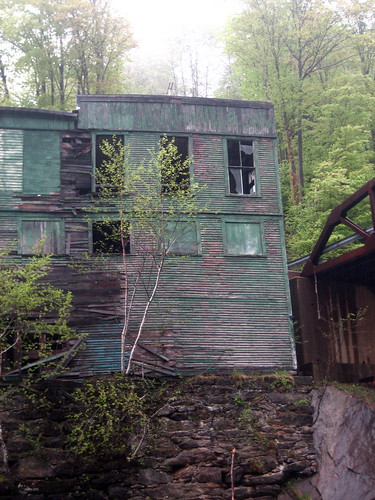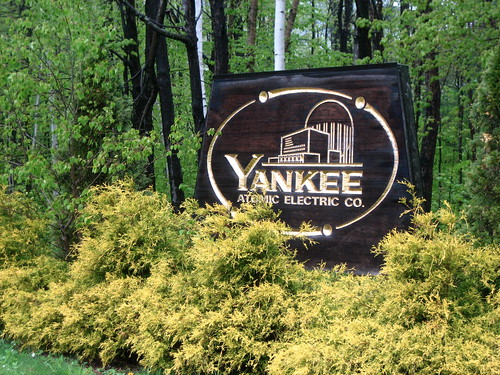I’ve been travelling less this year than I have the last two years, but I think I’m probably still on the road more than is strictly healthy. One of the best indicators I’ve had of this is a strange sort of homesickness. It isn’t the profound, all-consuming desire I have to sit on the couch and watch Red Sox games that I sometimes get when I’ve been on a road trip for weeks. It’s a desire to photograph western Massachusetts.
My Flickr sets are usually a good record of my travels. I rarely get on an airplane without a camera, and I have a rule that I haven’t actually visited a country unless I get in a good walk, which usually includes some photographs. But four of my latest sets – and some of the photos I’m happiest with – are of places in my own backyard. Yesterday, Rachel, Daniel and I set out to photograph Savoy, MA, two towns over from my town, and one of the most rural corners of Berkshire County. Driving on through Charlemont, Monroe and Rowe, MA, we photographed an abandoned summer camp, rusting railroad bridges, a long-dead paper mill and a disappearing nuclear plant.

This last destination probably requires some explanation. In 1960, the Yankee Nuclear Power Station – known locally as “Yankee Rowe” – commenced operation. Located in Rowe, MA, on the banks of the Deerfield River, this has to be one of the world’s most scenic power plants. When the plant was decomissioned in 1992, there was a great deal of local discussion and concern about how a facility located on a steep mountainside a long, long drive from any major highways. I’d always expected that, somewhere back in the woods, there would be a defunct nuclear plant, surrounded by high fences, klieg lights and tight security.
Daniel mentioned that he and his wife had gotten used to low-flying military aircraft over their house in Savoy and wondered if there was a base nearby. I speculated that the aircraft were coming from Westfield, MA, almost 50 miles south, but were likely flying over the nuclear plant. “Nuclear plant?” he asked, baffled, so we took off to find it.
And failed. I had dim memories of driving along the Deerfield River in northwestern MA and catching glimpses of the nuclear plant across the water, lit with orange spotlights. But while we explored half a dozen dams and pumping stations along the banks of the river, there was no nuclear reactor to be found.
That’s because Yankee Rowe has been decomissioned so thoroughly that there’s basically nothing left to see. There’s an amazing account of the removal of the 165 ton steel reactor core and its shipment to South Carolina in 1996 on the Yankee Rowe website – at one point, it involved driving a 365 ton load down 6.5 miles of very frightening mountain roads to load the core onto a rail car, which carried the huge package away.
While there’s very little evidence that there was ever was a nuclear facility in Rowe, MA, there’s still casks that contain 553 nuclear fuel rods, which need to be properly disposed of. Eventually, these assemblies are supposed to be placed in a permanent facility, like the one proposed for Yucca Mountain in Nevada. However, the US Department of Energy hasn’t opened such a facility yet, and so the highly radioactive assemblies are still in Rowe. In 2002, the fuel was moved from wet storage – basically storage in a giant swimming pool – to dry storage – sealed in steel canisters within concrete and steel casks. But those casks are still on site, until the DOE figures out where they should live, long-term.
Crossing the Deerfield from Monroe to Rowe, we passed an attractive wooden sign that let us know we’d found the right place. Down the road to the former nuclear plant, we found a few construction trailers, some traffic cones, and a surprisingly large colonial-style building. It looked like someone had decided that an appropriate future use for the Yankee Rowe site was either a huge private home, or a modest-sized bed-and-breakfast hotel. Either seemed like an odd choice – Rowe has a population of 351, Monroe of 102, and while both towns are very attractive, it seems unlikely that anyone would build either a ten-bedroom house or hotel here.
 So here’s my theory – the sixteen concrete casks, each weighing over a hundred tons – aren’t going anywhere any time soon. As long as they remain sitting on an otherwise idylic hillside, they’re an uncomfortable reminder that there’s tons of nuclear waste in temporary storage containers in a tiny Massachusetts town. So, with some of the $32 million dollars awarded to Yankee in a suit against the Department of Energy, I’m guessing – and that’s all this is, guessing – that there’s now an attractive colonial-style building currently surrounding 16 nuclear waste casks. (Worst… B&B… Ever!)
So here’s my theory – the sixteen concrete casks, each weighing over a hundred tons – aren’t going anywhere any time soon. As long as they remain sitting on an otherwise idylic hillside, they’re an uncomfortable reminder that there’s tons of nuclear waste in temporary storage containers in a tiny Massachusetts town. So, with some of the $32 million dollars awarded to Yankee in a suit against the Department of Energy, I’m guessing – and that’s all this is, guessing – that there’s now an attractive colonial-style building currently surrounding 16 nuclear waste casks. (Worst… B&B… Ever!)
All of which leaves me thinking about how the fractal way in which the world can be fascinating. My globetrotting lifestyle is more or less a direct reaction to my first trip to Africa in 1993 and the discovery that the world was so much bigger than I’d thought living in rural Massachusetts. Four hours of driving on a rainy Sunday has me realizing that rural Massachusetts is far, far more complicated, beautiful and fascinating than I usually think. Which leaves the inescapable conclusion that the world as a whole is likely fascinating to the extent that you choose to look closely at it.

A shot by Daniel of camp beds at the summer camp we spent an hour photographing. A good example of a view I missed completely and a gorgeous shot I probably never would have taken.
It’s rare that I get to look at the photos of two other people who’ve been looking at the same places I’ve seen. What I noticed, looking at Rachel’s and Daniel’s photos from our afternoon, is that I’m much more likely to step back and try to photograph a whole building, while they’re likely to focus in on a small, beautiful detail. I wonder if this can be read as a larger comment on my tendency to wander globally and theirs to wander locally? Or my tendency to overfocus on the big stuff and to miss the small stuff?

i don’t think you miss the “small stuff” by any stretch of the imagination, ethan. from where i sit you seem to *exist* in the details of local sets on a global stage in order to broadcast their reality into ever larger context, across numerous divides.
not many people have the opportunity, privilege, desire or the capability to do the same.
the “think global, act local” motto just fits so many of us who either can’t or wouldn’t follow a similar career focus and lifestyle that you’ve innovated to one degree or another.
for me, personally, i’d love to explore the global arena with 1/10th veracity that you do, but my day-to-day travels in my local environment becomes a world of opportunity to understand angles not visible to the naked eye.
that was more of a political and community centered statement than an amateur photographer’s take on locality. now, whether or not that actually takes root in my style of documenting the world around me — focusing on the micro patterns apparent in the world — i’ve no idea… but it is cool to think about and look for as i surf flickr streams of folk i know.
;)
Heh — funny you should pick out that camp bed shot; the only reason I got that was because I didn’t have a tripod and it was too dark to shoot hand-held in there. So what’s a guy to do but put his camera on the floor?
If we’re going to read anything into that, perhaps it’s that to whatever extent I succeed, I tend to do it by accident…?
Pingback: El Oso, El Moreno, and El Abogado » Blog Archive » On Wonderment and Gestures, Macro and Micro
I helped to decommission YAEC. It was perhaps the most beautiful nuclear site in the nation. I felt lucky to work there every day of my tenure.
Pingback: Citizen science versus NIMBY? | ... My heart’s in Accra
Comments are closed.